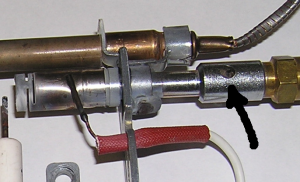Since 1980, all unvented heaters, including vent-free gas logs and alternative fires, have been equipped with Oxygen Depletion Sensor Pilots (ODS). The designs of all makes of these calibrated pilots have a common feature and a common result: they have a small hole or holes that draw air in to mix with the gas to make the pilot flame. With the air is also dust and lint which accumulates over time. Eventually, the accumulation becomes an obstruction which disrupts the proper operation of the pilot flame. This is common to all vent-free gas log sets, not just Rasmussen Chillbuster or Alterna VF sets.
The typical symptoms that your customers will contact you about include: a) Unable or difficult to establish the pilot light; or
b) Pilot lights, but the burner(s) and/or pilot shuts down after a few minutes of operation.
Action to Take, either by the homeowner or by your service team on a paid call:
1) Gather tools needed:
a) Vacuum cleaner with brush attachment
b) A can of compressed air with a tube (the type that is used to clean computer keyboards) or a drinking straw.
2) Vacuum up all lint, dust & debris from logs, grate, burner(s), burner air intake and air shutter regions (underneath burner, where air gets drawn in), and pilot area. View photo of burners.


3) Using the compressed air or a straw, blow out:
a) Burner ports (where the main flame comes from); View photo of burners.
b) Burner air intake and air shutter regions (end of burner(s) where gas and air mix); View photo of burners.
c) Around the valve knob (the one you depress to light the pilot); and
d) MOST IMPORTANTLY, the air intake holes of the ODS Pilot Assembly. These small air intake holes are between 1/16″ and 1/8″ in diameter and are located about 2” from the end of the pilot from where the pilot flame originates. Use the compressed air or straw to blow out these holes. Repeat a couple of times.

On some ODS, the top hole is covered by a thin metal strip. Slightly lift the metal strip and point tube or straw directly into the hole and blow out several times. Be careful not to permanently bend this strip when accessing the hole).
We recommend that customers perform this maintenance annually before the start of the heating season, more often if the symptoms reoccur. This is a perfect opportunity for dealers to enter into a Seasonal Start-up Maintenance contract with their customers – cash flow!

